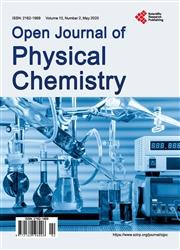Thermodynamic Study and Spectroscopic Analysis of a Charge-Transfer Complex between 3,5-Diamino-1,2,4-Triazole and 6-Methyl-1,3,5-Triazine-2,4-Diamine with Chloranilic Acid
引用次数: 1
Abstract
Studying of charge-transfer (CT) and proton transfer interactions is essential due to their important role in many biological field and industrial applications. The current work will add more information’s about the nature of interaction between 3,5-diamino-1,2,4-triazole (DAT) and 6-methyl-1,3,5-triazine-2,4-diamine (MTDA) with 3,6-dichloro-2,5-dihydroxy-p-benzoquinone (chloranilic acid CLA) which was studied spectrophotometrically in Ethanol (EtOH) and Methanol (MeOH) solvents at different temperatures. The molecular composition of the formed complexes was studied by applying continuous variation and spectrophotometric titration methods and found to be 1:1 charge transfer complex for both Complex (DAT:CLA) and (MTDA:CLA) which are produced. Minimum-Maximum absorbance’s method has been applied to calculate the formation constant KCT and molecular extinction coefficient (e); they recorded high values confirming high stability of the produced complexes. Oscillator strength (f), transition dipole moment (μ), ionization potential (IP) and dissociation energy (W) of the formed CT-complexes were also determined and evaluated; they showed solvent dependency. It is concluded that the formation constant (KCT) of the complexes is found to depend on the nature of both electron acceptor and donors and on the polarity of solvents.3,5-二氨基-1,2,4-三唑与6-甲基-1,3,5-三嗪-2,4-二氨基与氯苯胺酸电荷转移配合物的热力学研究和光谱分析
电荷转移(CT)和质子转移相互作用的研究是必不可少的,因为它们在许多生物领域和工业应用中发挥着重要作用。目前的工作将增加更多关于3,5-二氨基-1,2,4-三唑(DAT)和6-甲基-1,3,5-三嗪-2,4-二胺(MTDA)与3,6-二氯-2,5-二羟基对苯醌(氯苯胺酸CLA)之间相互作用性质的信息,该相互作用是在乙醇(EtOH)和甲醇(MeOH)溶剂中在不同温度下用分光光度法研究的。用连续变化法和分光光度滴定法研究了所形成的配合物的分子组成,发现所产生的配合物(DAT:CLA)和(MTDA:CLA)都是1:1的电荷转移配合物。应用最小-最大吸光度法计算了形成常数KCT和分子消光系数(e);它们记录了高值,证实了所产生的复合物的高稳定性。测定并评价了所形成的CT配合物的振子强度(f)、跃迁偶极矩(μ)、电离势(IP)和离解能(W);它们表现出溶剂依赖性。结果表明,配合物的形成常数(KCT)取决于电子受体和给体的性质以及溶剂的极性。
本文章由计算机程序翻译,如有差异,请以英文原文为准。
求助全文
约1分钟内获得全文
求助全文

 求助内容:
求助内容: 应助结果提醒方式:
应助结果提醒方式:


